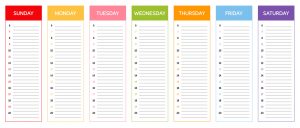Time-Saving Tips for Teachers
- 30 August, 2020 //
- Teaching Resources //
- Tags : teacher tips, time management
- Comments Off on Time-Saving Tips for Teachers
 Teachers work a lot. In fact, many teachers work well beyond their contracted hours grading papers, planning lessons, and overseeing extracurricular activities. Add in trying to spend time with a spouse or raise children and it becomes clear that there just aren’t enough hours in the day. For teachers, anything that can save a little time can be life-changing. If you find yourself giving up sleep or foregoing fun activities to get classroom work done, try some of the time-saving tips for teachers below to gain a little more margin in your life.
Teachers work a lot. In fact, many teachers work well beyond their contracted hours grading papers, planning lessons, and overseeing extracurricular activities. Add in trying to spend time with a spouse or raise children and it becomes clear that there just aren’t enough hours in the day. For teachers, anything that can save a little time can be life-changing. If you find yourself giving up sleep or foregoing fun activities to get classroom work done, try some of the time-saving tips for teachers below to gain a little more margin in your life.
Embrace the 40-hour Workweek
Many teachers have taken on Angela Watson’s 40-Hour Teacher Workweek which focuses on strategies to help keep school at school and allows teachers to spend more time with their families and friends. There’s always a waitlist to join the latest cohort, but you don’t have to officially join the movement to try it out. Look for Facebook groups and blogs from teachers who have taken on the challenge and start by implementing some of their strategies.
Develop Routines

The more routines you have in place in your classroom and at home, the less time you have to spend planning. For example, maybe you always teacher grammar on Wednesdays or your students spend every Friday brushing up on their math facts. At home, you can plan to eat pizza every Friday or tacos every Tuesday and be sure to always have the ingredients on hand (or a delivery app on your phone) ready to go.
Stop Reinventing the Wheel
While it’s true that every group of students has different needs, that doesn’t mean that you need to write an entirely new curriculum every year. If you have lessons that have consistently worked well, keep using them rather than trying to come up with something fun and new. And remember that you don’t have to have an exciting, fun lesson every day. In fact, spacing out the exciting lessons and filling the time in between with practice opportunities and reinforcement can help improve student retention.
Additionally, don’t feel like you have to create everything yourself. Did you see the perfect rubric or slideshow presentation online? Use it. If you find the perfect resource on TeachersPayTeachers, buy it. You don’t have to feel bad because you didn’t create it yourself. Sites like HelpTeaching.com exist to help teachers save time by providing worksheets, video lessons, and other activities for their classrooms.
Get Digital Assistance
In today’s digital world there are tons of resources designed to save teachers time. You can keep up with an entire class of parents at once by using a service like Remind or quickly log behavior issues (positive and negative) with Class Dojo. There are also numerous Word, Excel, and Google templates designed to make record-keeping easier.
If you teach online for a service like VIPKid or have to keep detailed notes about your students and their performance, consider signing up for a service like Feedback Panda. Their templates make it easy to record student progress, write detailed course notes, and quickly review critical information about students.

Pay Attention to When and What You Grade
How many times have you brought a bag of papers home to grade only to take it back the next day with the papers ungraded? Even when teachers don’t look at the work they bring home, they spend a lot of time thinking about it. If you’re feeling stressed or have other things to get done, just leave the work at school. Then you don’t have to spend time worrying that you should be grading them because it’s not an option. Additionally, try to set due dates for larger assignments at times when you know you’ll be able to get the grading done and don’t be afraid to extend a due date if your week is filling up. Your students likely won’t complain about the extra time to get the work done.
Along with looking at when you grade, think about what you grade. Do you really need to grade every paper? If the students’ quality of work wasn’t up to par, consider chucking the assignment and trying again. If something was just for practice or participation, slap a check mark on it and hand it back, only adding comments if there are serious issues. If you give a writing assignment, rather than marking every error, provide more general feedback at the end. You can also look for ways to give students feedback on their work in class rather than offering a formal grade or implement peer grading for assignments that carry a lower weight.
Learn to Say No
It’s definitely easier said than done, but knowing your limits and learning how to say no can help you free up time in your schedule. Does a parent want you to tutor a student after school? Maybe you can suggest some resources for the student to review at home instead. Does your principal need someone to chair another committee? Maybe you can suggest a colleague who’d be better suited for the job. Do your kids want you to cart them around to activity after activity? Maybe you can have them choose one activity every 6 weeks or ask their friends’ parents to help carpool so you don’t have to be responsible for drop off and pick up every time.
Take Care of Yourself 
Even though self-care takes time, taking time to take care of yourself can actually add more time to your schedule. When you are tired and stressed, you work at a slower pace and likely don’t think as clearly. Taking a few hours every week to focus on relaxing and recharging can make it easier to get everything on your list done without feeling overwhelmed.
Embrace Imperfection
The problem with Instagram and Pinterest is they can make teachers feel like they have to have the perfect classroom, the perfect lesson, the perfect… everything. At the end of the day, your students and loved ones don’t care if you had a Pinterest-worthy lesson or the most Instagrammable classroom decor. They just want someone who loves and cares about them. So if you don’t have a classroom full of color-coordinated flexible seating, your walls aren’t covered with your professionally designed anchor charts, and you don’t have a Cricut-made t-shirt for every occasion, it’s okay.* That’s probably not what your students will remember anyway.
*And if you can maintain that Pinterest-worthy classroom, have a Cricut-made t-shirt for every occasion, or create anchor charts that show amazing graphic design skill, there’s nothing wrong with that either as long as it doesn’t come at the expense of taking care of you.


